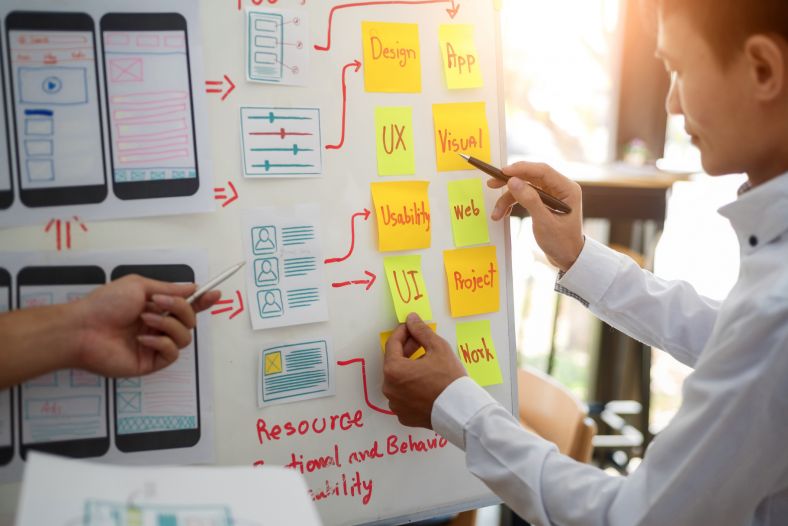Part 1: How our design and research teams work and learn together
The NSW Government Digital Channels team uses the strengths of each individual designer to design and optimise our online customer experiences. Find out who we are, how we work and some examples of the tools we use.
Who we are
The NSW Government Digital Channels Design team comprises of a variety of disciplines, including:
- Service Designers: leading the beginning of projects, service designers facilitate workshops with subject matter experts, research specific audiences, and synthesise research to create design artefacts that help inform the team about what problems need solving. They also propose content models and information architectures for the customer journeys.
- UX (user experience) Designers: propose solutions to the problems that need to be solved. They create new designs and prototypes.
- UX Researchers: when prototypes are designed, UX researchers test our audiences and determine whether users can comprehend the content and use the interfaces. We use a variety of tools and methodologies to thoroughly test our designs, then the insights are documented to iterate and improve the designs.
- UI (user interface) Designers: detail is then provided to the designs and the interfaces and interactions are refined by UI Designers. These refined designs often go through additional rounds of research until the experiences are released.
How we work
The design team takes a collaborative approach to guiding projects through the diverging and converging processes.
The design team has a variety of meetings and communication channels, each with different agendas and purposes. These purposes include:
- Combining research activities: we often have multiple teams trying to solve problems for similar audiences. For example, we are currently supporting several initiatives to help small and medium businesses in NSW. This means we can engage with business owners to discuss their pain points, understand their processes and test multiple prototypes. The findings can then be shared efficiently across designers and researchers who work together to test ideas.
- Improving the effectiveness of research: there are many ways to approach research. By bringing research practitioners together on a regular basis, it provides an opportunity to identify research processes that are working well and those that are not. This gives us an opportunity to create an action plan to improve the efficacy of research. Our research practitioners have a varied background and experiences, so they’re able to provide feedback on a range of approaches to research.
- Design communities: before designs go through the governance and approval process, there is an opportunity to consult the design community. This encourages our designers to self-organise and establish a forum for informal conversations and early feedback. The outcome is a community of practice that shares knowledge, builds better practices, and contributes to organisational collaboration. Our design and research communities require structure, leadership and support to be effective. The communities are broken into small groups of designers, so it is less intimidating. The communities use online chats and meet remotely to discuss ideas

Our tools
We use a range of tools to help collaborate, recruit audiences, assess concepts and document insights.
- Audience recruitment: to gain insights about different topics, we recruit subject matter experts and audiences relevant to the topics. We also ensure that we recruit with inclusivity in mind. We have recruitment processes and organisations that enable us to recruit people living with a disability, people from culturally and linguistically diverse backgrounds, and Aboriginal and Torres Strait Islander communities.
- Information Architecture assessment: we often need to assess the structure of a site, to ensure it is navigable for users. Online tools are used to facilitate card sorting activities, allowing users to organise key tasks into a structure that makes sense to them. We can also test a proposed structure, to understand if users can complete a task within the proposed structure. These methodologies are called open card sorting and closed card sorting.
- Collaboration: we use a variety of tools that help us collaborate remotely. These tools create virtual spaces where sticky-notes and research stimulus are used to encourage participation from stakeholders, subject matter experts and target audiences. These collaborative tools also help us define our content modelling and customer journeys.
- Synthesis: once we have learned more about the subject matter, we find affinities in the insights and bundle online sticky-notes to identify themes for the team to focus on.
- Collaborative design: once a direction is provided from the research, we use collaborative design tools to create prototypes.
- Automated design assessment: we use a variety of tools to assess our designs. We use automated only tests that display users with the proposed designs, to test if they can complete the tasks assigned. We can also create surveys, to test if they comprehend the content on the page.
- Moderated usability testing: we can remotely test prototypes online with research participants. The participants test our designs and we then have an opportunity to ask probing questions in real time to better understand why they are interpreting an interface or navigating content in a particular way.
- Centralising research insights: we contribute and reference research in a centralised register. When insights are documented, they are labelled by topic. For example, if multiple teams are generating insights on small businesses, each can draw on the existing knowledge in a central location.
The key focus of our UX Design team right now, is making sure we create a stronger foundation for consistently high-quality research and design. This will ensure that we continue to create world class experiences for our customers.
This is a 2-part blog series on UX research:
Part 1: How our design and research team works together and learns together
Part 2: Governance for high-quality design
Stay in touch
Want to know more about the OneCX program? Subscribe to our newsletter for the latest news and updates.